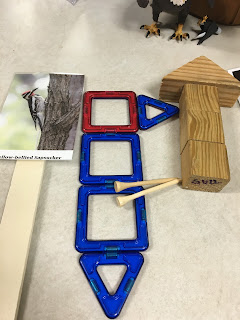I have mentioned the book Woodpecker Wham! by April Pulley Sayre various times in the past. She has great nature books for children! I was inspired by this book to create these experiences. It was great when she gave us a shout out on Facebook as "creative and passionate" people make her book come to life. See my review of the book here and a related blog post about Woodpeckers in our area. This gives a good overview and links to resources with more information about woodpeckers. I reviewed these to make the woodpecker clues and to have information to share at the presentations.
I hosted a few programs:
- Nature Play--activities available if people wanted to use them, I read the book if someone is interested and talked about woodpeckers while children played and created.
- Woodpeckers in Winter--developed a PowerPoint of the woodpeckers in our area, sharing information on identification, behaviors in winter, how designers look at woodpeckers for inventions, attracting woodpeckers to yards, deterrents from woodpecker damage, and quizzing the participants with the use of woodpecker clues.
- Family Nature Club--read the book, short run through the PowerPoint to identify woodpeckers in our area, guided hike looking for signs of woodpeckers, good woodpecker habitat, brought puppets and clues to test woodpecker knowledge on our hike. Inside once again, stations were set up to reinforce what we learned about woodpeckers.
Printable Resources I Created:
Woodpecker Puppets or Matching Cards
Woodpecker Clues
Here are the stations I set up:
Puppets and Matching Cards--I printed out (see printable above) two sets of the woodpeckers in our area, cutting them out and laminating. One set was taped to paint sticks for puppets. The others were for matching with our woodpecker clues (see printable above). We found the woodpeckers in the book, used puppets during the PowerPoint presentation to match with the clues, took the puppets on our hike to reinforce the concepts, and used the puppets for PLAY! Play is always an important concept for learning. See a related post on using play to learn about animals here. The woodpeckers even found wood for drilling.
Build a Woodpecker--Provide "loose parts" to build woodpeckers. I brought in Magformers (a favorite in our house--actually my husband's toy!) and a basket full of shells, nuts, golf tees, and other natural materials. Can you see a woodpecker in these examples? We used the puppets as examples, so we could pay attention to the shape, coloring, etc. This could be much more complex if desired. What I love about loose parts play? No artwork to store or recycle! See my post on resources and quotes about Loose Parts Play. I even have a Loose Parts Play Facebook group if you'd like to connect with others around the world using Loose Parts Play for learning.
Fold a Woodpecker--I found an origami guide sheet to make woodpeckers! It's pretty nondescript, but offers another way to connect to woodpeckers. We build many skills by following the directions, making precise folds, etc. I used to teach elementary school in Japan--glad we could make cross cultural connections, too.
Reading and Coloring--I had Woodpecker Wham! and Vulture View (by the same author) out on a table with coloring sheets, information sheets about woodpeckers from Birds & Blooms magazine in sheet protectors, a quiz from B&B, a poem about woodpeckers, and bird observation journal sheets.
Craft a Bird--A volunteer (thanks, Annie!) had an idea to make paper birds like this. She cut out the various pieces after creating a pattern, figured out feet with twisty ties (cool idea!), and
Extension Ideas:
- Build a woodpecker nesting box
- Make homemade suet to attract woodpeckers
- Use props (such as goggles, a bill, etc.) to show unique adaptations of woodpeckers
- Create action cards from the various woodpecker action in the book to act out while on a hike or during story time
- Find a readers theater to share about woodpeckers
- Read traditional stories about woodpeckers, like Hiawatha
- Share videos of woodpeckers in action--maybe have tablets with some preloaded to view
- Use the Identiflyer (aft link) or an app to learn the calls of different woodpeckers
- Print large pictures of the birds, using yarn to create a "sign" of each one. Place the picture on the child's back. Play 20 questions around the room, asking others questions to figure out the birds. This can also be done with the animals and info sheets in folders to discuss.
Here are a few shots from our guided hike. We had a great family of girls who are always outside and a new family of boys that obviously have a lot of experience in nature. I was glad I could still share a few things to help extend their experience, too. :-) We found good habitat for woodpeckers, talked about what they eat, and the kids actually found 2 woodpeckers--a downy and a red-bellied! That was neat to see them in action!
It was a beautiful day to be outside and we could have stayed outside for longer!
It was neat to see the kids building woodpeckers and such after we came back inside after the hike. They were really getting into their building, creating woodpeckers (left), complicated bird houses with several levels (picture on the right), and more!
They had lots of fun!


















